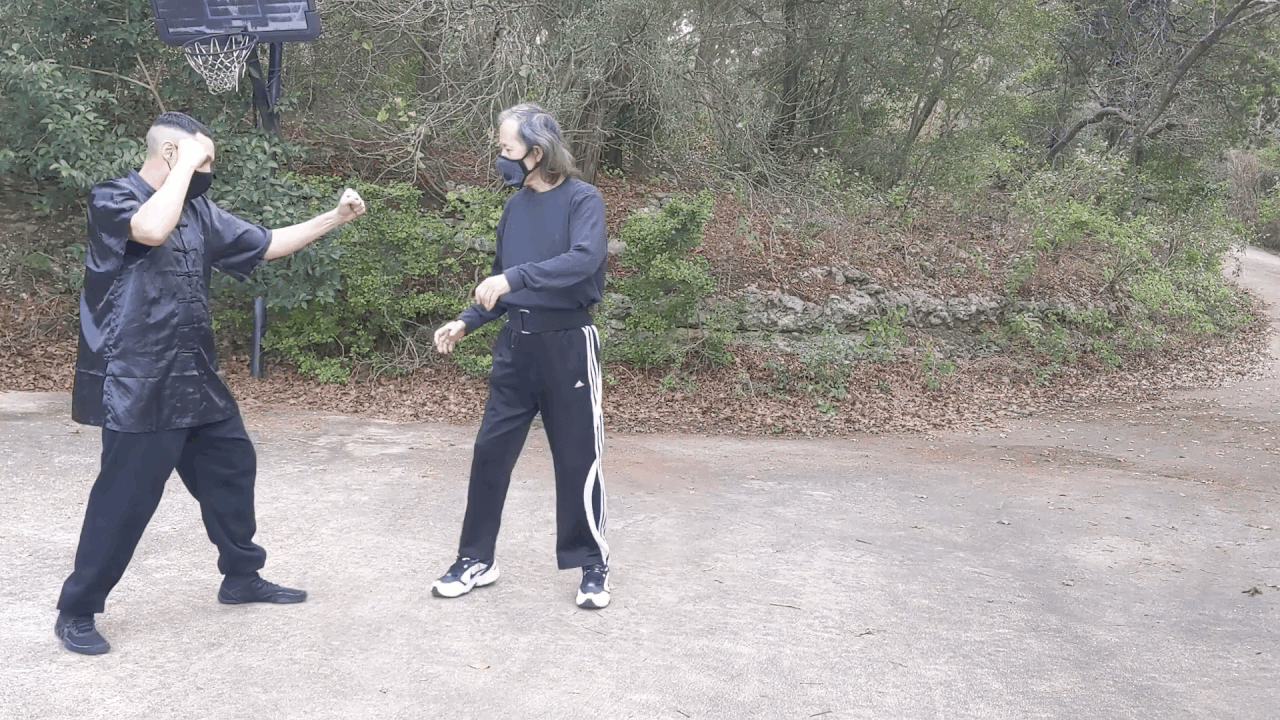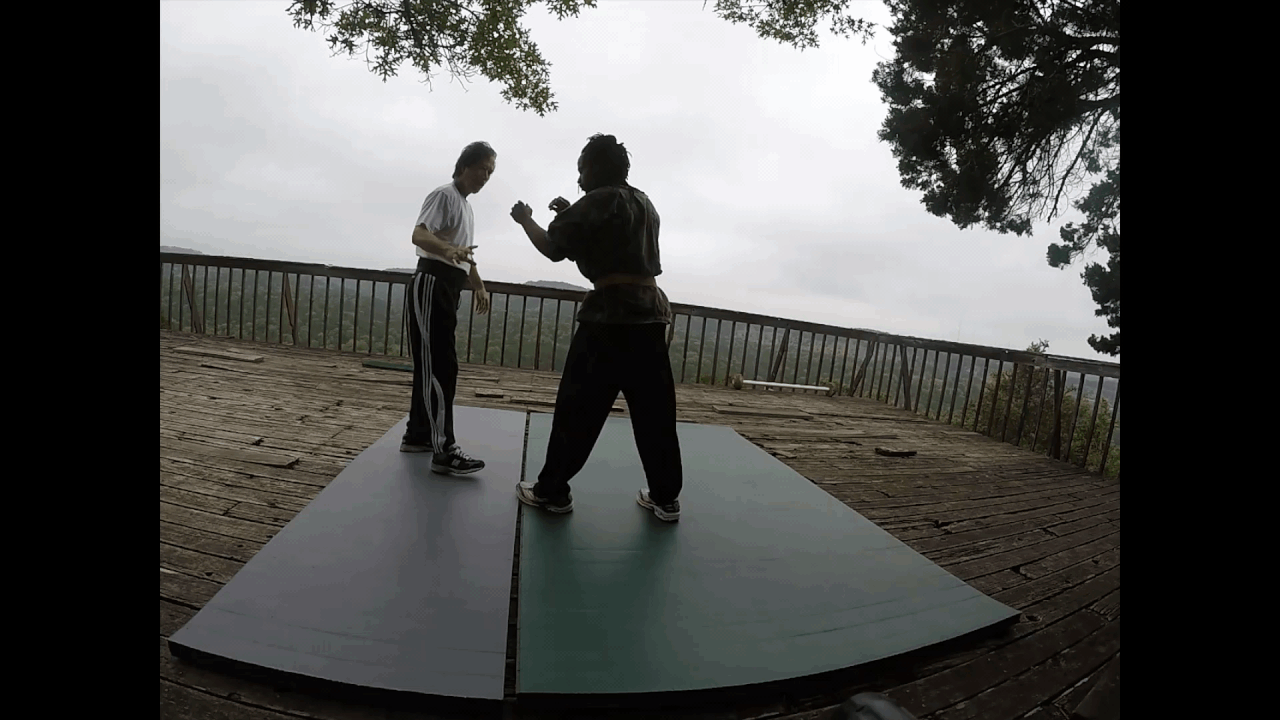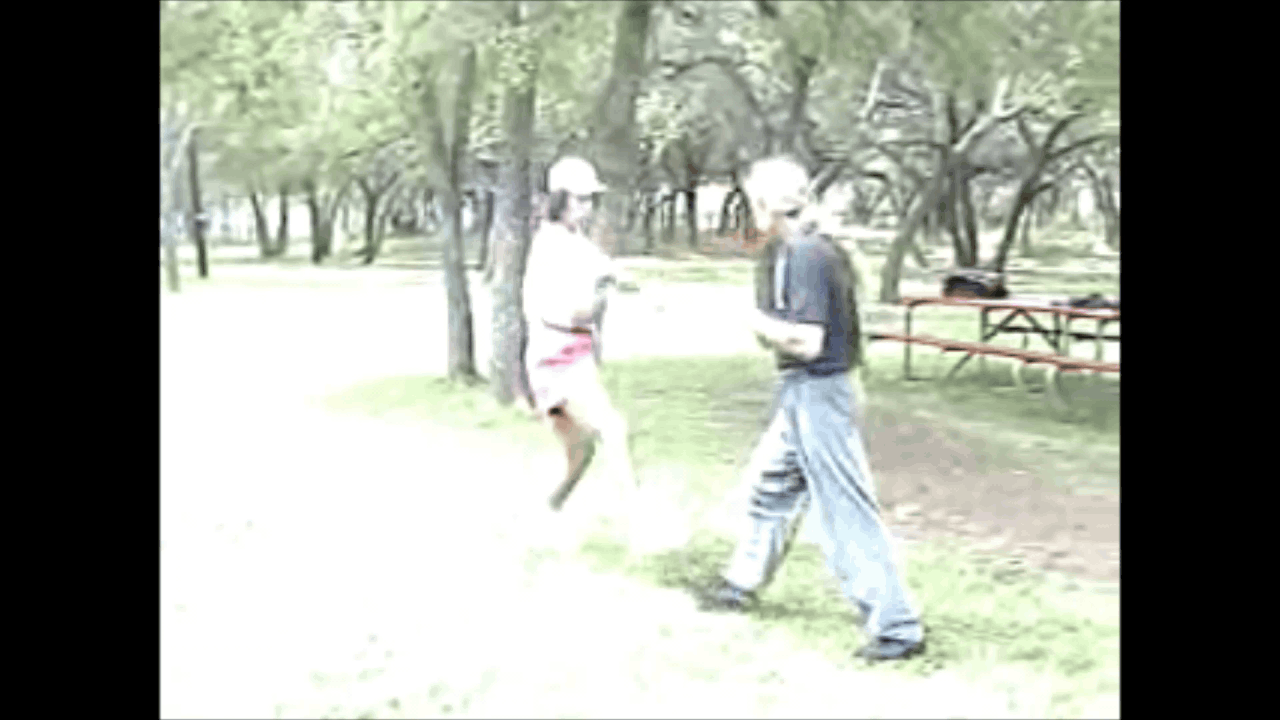Navigation
Install the app
How to install the app on iOS
Follow along with the video below to see how to install our site as a web app on your home screen.
Note: This feature may not be available in some browsers.
More options
Style variation
You are using an out of date browser. It may not display this or other websites correctly.
You should upgrade or use an alternative browser.
You should upgrade or use an alternative browser.
Attacking the Guard
- Thread starter JowGaWolf
- Start date
If you knock on your opponent's guard down, your opponent can borrow your force, spin his arm and hook punch back at you. In order to prevent that from happening, it's better to knock/grab on your opponent's wrist. Of course, it's impossible to do when you have gloves on.
"Knock down guard -> grab wrist" should be integrated into 1 move, otherwise, "knock down guard -> comb hair -> arm wrap" should be combined into 1 move (in case your opponent borrows your force and hook punch you back).
To disable your opponent's arm mobility is better than just to knock his arm away. Same reason I don't like "push". You push your opponent away; he will come back to you. But if you put him under your knee, he will remain there.
"Knock down guard -> grab wrist" should be integrated into 1 move, otherwise, "knock down guard -> comb hair -> arm wrap" should be combined into 1 move (in case your opponent borrows your force and hook punch you back).
To disable your opponent's arm mobility is better than just to knock his arm away. Same reason I don't like "push". You push your opponent away; he will come back to you. But if you put him under your knee, he will remain there.
Last edited:
Feel free to go for that option if you think you can sneak a hook in. Just based on how I throw these punches it's not always an overhand strike. Sometimes that lead hand turns into hook sometimes it's an elbow. In the video above, he takes a linear drive. In application you want to step off at a 45-degree angle. Unless the intention is to drive the person backwards.If you knock on your opponent's guard down, your opponent can borrow your force, spin his arm and hook punch back at you. In order to prevent that from happening,
I wouldn't do it. If they step 45 degrees in the opposite direction of the incoming punch, then you'll get nailed while trying to hit something that is no longer there. There are just too many different types of strikes that can come off that second punch to risk something like that. The assumption is that the 2nd strike would be an overhand and it's not always an overhand.
You have 2 options here. You canto strike the arms.
1. strike your opponent's arm down.
2. guide your opponent's arm away from your attacking path.
IMO, 1 < 2
because
- your opponent is difficult to borrow your force.
- you can control your opponent's arm longer.
- you use less energy to achieve the same goal.
- you are less commit -> you can have more speed and less risk.

Last edited:
isshinryuronin
Senior Master
This is one of the biggest mistakes I see in sparring - wasted effort. Simply moving the guy's guard, or even blocking, is a wasted opportunity if there is no offensive follow-up. And getting a grab in gives you more options and control.To disable your opponent's arm mobility is better than just to knock his arm away.
Maybe true of many styles and often represented in kata bunkai, but not put into application by most individuals in my experience.I don’t think I’ve ever seen a style that doesn’t have techniques that attack or trap the guard.
I was thinking this same thing watching the video. Closing in on an angle would optimize the guard attack maneuver and facilitate a counter. Even closing straight in, working your way up the guard: wrist>elbow>upper arm and shoulder. Now you're in biting distance.In the video above, he takes a linear drive. In application you want to step off at a 45-degree angle.
I believe there are 2 different kinds of fighting.is a wasted opportunity if there is no offensive follow-up.
1. You attack, your opponent moves back, your opponent attacks, you move back, ...
2. You wait for the best opportunity, move in, and finish the fight.
1 has no plan. 2 has plan.
When I was just a striker, I used plan 1. If I can't knock my opponent down in friendly sparring, the word "finish" has no meaning in friendly sparring. You attack me; I move back. I attack you; you move back. This becomes very normal in striking game sparring. After I became a wrestler, to take my opponent down ASAP became my goal. I started to appreciate plan 2 better.
Last edited:
When I first started learning how to do the long strikes. I learned that I need to take angles. I had to eat a few punches to learn but I learned. I aslo learn that some of the punches that we trained by moving forward work better when we move backwards.I was thinking this same thing watching the video. Closing in on an angle would optimize the guard attack maneuver and facilitate a counter. Even closing straight in, working your way up the guard: wrist>elbow>upper arm and shoulder. Now you're in biting distance.
As Wang moves forward to grab the lead arm a step back with the left leg will set up a long fist strike with his rear hand provided that this rear hand is elbow down and not guarding his head. Having the guard up that high makes it difficult to quickly hide the rear arm behind the body. This would work on someone like Wang who always likes to move forward. It won't work on someone if they aren't eager to move forward.
I don't like to move a guard unless I can pull them off bance for a quick second. Throw a punch at someones head and he'll put the guard up for you to hit. Instead of targeting the head target the guard and the force will be delivered at full impact upon the guard.Simply moving the guy's guard, or even blocking, is a wasted opportunity if there is no offensive follow-up.
This works because the power is intended for the head. This will not work if the power is intended for guard. Send a strike toward someones head and they will freely give their arm. If I swing in the direction of someone head then the assumption is that I'm aiming for the head.
With long fist techniques, this is way too close for any big swings. If I'm doing long fist techniques and someone can touch that far beyond my elbow then I was in trouble long before I got into this position.
This is good distance for the 1st or 2nd long fight strike in a combo. The only bad part here is the foot off the ground and the fist at the waist. My personal thought is that his Sanda is bleeing into his Jow Ga. But if the first strike is at this range the second one will land. The video actuall shows what you are talking about not having an offensive follow up. If you want the video you can see the teacher show him how to roll the backfist for that follow up offensive, but it doesn't look like this student uses that technique. For Jow Ga it's the only way to fill in the gaps of the big swings.
windwalker099
Master Black Belt
A few months ago, there was a discussion about striking arms. I mentioned that Jow Ga trains to strike the arms. Here's an example. Of what that looks like. This is just one of the many ways we strike arms.
One of my favorite movements within Tibetan White Crane is to directly take out the lead arm. Either directly or using what was called "burning hand" The strike would numb out the opponents arm causing them to drop it...Or stop everything, not being able to continue.
The footwork is a bit different but follows the same concept.
Taiji is similar in that any point touched becomes the point where force is issued, affecting the whole body.
No need to target the body directly.
In your demo GIF, the problem with "attacking the guard" is you are stepping and grabbing your opponent's wrist in the guard position. As you step and attempt to grab, your opponent could move and/or counter instead of freezing.You have 2 options here. You can
1. strike your opponent's arm down.
2. guide your opponent's arm away from your attacking path.
IMO, 1 < 2
because
- your opponent is difficult to borrow your force.
- you can control your opponent's arm longer.
- you use less energy to achieve the same goal.
- you are less commit -> you can have more speed and less risk.

Instead of attacking the limb, one can enter, control and attack the center on first contact aka, kuzushi on contact...
From the start of the OP video, “The judo way of throwing… cannot be used in Aikido… In aikido, the opponent is unbalanced through the use of atemi [from a distance, not via gripping]... We don’t do it this way. When the opponent punches, we enter directly. Taking Initiative Instead of Blocking. This is not acceptable as a martial technique. Because when you parry him here, he will attack with the other hand. Block and counter. You can’t consider this way of doing it to be aikido… You have to have already defeated your opponent before being touched. You can’t attempt to grab after being struck. Our way of doing it is to enter, thus preventing him from striking. That’s how we execute the movement. Our way of grabbing is different too… In the usual way, you execute the movement after receiving the strike. We enter directly... We invite him to strike then enter… The hand that comes into contact with the opponent is to draw him out."
"We don't do it this way." With the front foot planted, the opponent can throw a feint, straight left, check hook or move back by pushing off the front foot...

“We are in this position.” From this position, the opponent is double weighted and hasn't landed his punch...

Shoji makes sense. His method follows universal concepts. It applies to both striking and throwing. There is empirical evidence that it works "live" in high level fighting.
Rick uses economy of movement with the shuffle step and controls the opponent with the lead hand, while his opponent takes a full traditional step to throw the lead punch.
If I fully commit on my hook punch, when my opponent changes, I may not be able to change with him. Since I'm not fully committed, when my opponent changes, I can change too.In your demo GIF, the problem with "attacking the guard" is you are stepping and grabbing your opponent's wrist in the guard position. As you step and attempt to grab, your opponent could move and/or counter instead of freezing.
In this clip, I use the same entering strategy. My opponent rotates his arm (it doesn't show in the video, but it can happen), so I lost control on his wrist. Since my goal is not on his wrist but on his upper arm, his changes help me to make my change too.- you are less commit -> you can have more speed and less risk.
In other words, when I grab my opponent's wrist, I do want him to respond so I can take advantage on. My goal is not on his wrist but on something else.

Last edited:
isshinryuronin
Senior Master
You are correct, as you describe it. However, the problem is between the "stepping and grabbing." There is a step missing. It is difficult in a combat situation (where the attack is not a simple grab) to apply a grab directly, for the reasons you point out here.the problem with "attacking the guard" is you are stepping and grabbing your opponent's wrist in the guard position. As you step and attempt to grab, your opponent could move and/or counter instead of freezing.
There has to be an initial attack on the guard prior to the grab to immobilize it, move it and put the attacker out of position to counter, or in a fashion that, as you later mention, kazushi (structural balance) is affected. Only then will the grab have a high percentage chance of being successfully set.
To use a punch to set up a grab/pull is commonly used in all MA system. It's just not showing in that video.between the "stepping and grabbing." There is a step missing. It is difficult in a combat situation (where the attack is not a simple grab) to apply a grab directly, for the reasons you point out here.

drop bear
Sr. Grandmaster
When I attack the guard I try to do so in a manner that still protects me from counter attacks.
If I smash down on one side and he limp arms. Then I have attacked my own guard.
I mainly do 2 things. Throw punches untill they tight cover then cross sides Dutch trap then throw a hook with the other hand.
Or my super fun one.
If he has a long guard. I cross over. Pull his guard inwards. Flair my elbow in a bong sau.
And throw the other hand.
Then I take the bong sau hand and throw a reverse hammerfist uppercut.
I have seen a hook to the inside of the elbow then uppercut that I want to try.
Then throw the other hand again.
If I smash down on one side and he limp arms. Then I have attacked my own guard.
I mainly do 2 things. Throw punches untill they tight cover then cross sides Dutch trap then throw a hook with the other hand.
Or my super fun one.
If he has a long guard. I cross over. Pull his guard inwards. Flair my elbow in a bong sau.
And throw the other hand.
Then I take the bong sau hand and throw a reverse hammerfist uppercut.
I have seen a hook to the inside of the elbow then uppercut that I want to try.
Then throw the other hand again.
Yes. You...I mainly do 2 things. Throw punches untill they tight cover then cross sides Dutch trap then throw a hook with the other hand.
1. lead the opponent by feinting with the rear hand shifting your weight to the front foot which loads the lead hook.
2. as the opponent moves from the on guard position to the shell defensive position, throw the hook by transferring your weight to the back foot.
Yes, you time the opponent. As they move from the on guard position to the long guard, you counter them.Or my super fun one.
If he has a long guard. I cross over. Pull his guard inwards. Flair my elbow in a bong sau.
And throw the other hand.
Then I take the bong sau hand and throw a reverse hammerfist uppercut.
I have seen a hook to the inside of the elbow then uppercut that I want to try.
Then throw the other hand again.
Last edited:
When you attack your opponent's guard, you have 2 options:
- Guide his leading arm to jam his back arm, so you can enter through his side door.
- Separate his arms away from his head, so you can enter through his front door.
Which door that you want to enter, depend on your plan (finish move).
- Guide his leading arm to jam his back arm, so you can enter through his side door.
- Separate his arms away from his head, so you can enter through his front door.
Which door that you want to enter, depend on your plan (finish move).
Last edited:
If you attack by stepping and attempting to grab, jam or separate your opponent's guard, then your opponent can react in various ways other than freezing.When you attack your opponent's guard, you have 2 options:
- Guide his leading arm to jam his back arm, so you can enter through his side door.
- Separate his arms away from his head, so you can enter through his front door.
Which door that you want to enter, depend on your plan (finish move).
MA is like playing chess, you make 1 move, your opponent also makes 1 move.If you attack by stepping and attempting to grab, jam or separate your opponent's guard, then your opponent can react in various ways other than freezing.
The normal fight should not be.
- A attack B and knock B down.
The normal fight should be:
- A attack B.
- B counter A.
- A counter B again.
- B counter A again.
- ...
Similar threads
- Replies
- 122
- Views
- 12K
- Replies
- 0
- Views
- 964
- Replies
- 20
- Views
- 3K
- Replies
- 162
- Views
- 17K
Latest Discussions
-
-
-
-
-
Why Wouldn't A Good Athlete Be Good In The Martial Arts
- Latest: Prince_Alarming
-
